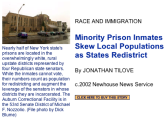Ten years ago: PPI releases first report about prison-based gerrymandering
Democracy and criminal justice activists rejoiced, but the initial media response was much cooler.
by Peter Wagner, April 26, 2012
This article is one in a series commemorating the 10 year anniversary of the Prison Policy Initiative and our work.
The Prison Policy Initiative released our first report ten years ago last Sunday.
Importing Constituents: Prisoners and Political Clout was the first in-depth district by district analysis of what we now call prison-based gerrymandering. I analyzed each proposed New York State Senate and State Assembly district, looked at where incarcerated people came from, and suggested both interim and long-term solutions.
This report was the first of dozens of analyses we issued over the next decade. This first report was tough going. I hadn’t yet been introduced to Rose Heyer, who developed the electronic research methodology for the project, so all of the analysis was done manually. Every time the legislature changed the proposed plans, I’d have to start over.
After several rounds of this, I recruited some of my fellow law students, Tammy Ciak and Ann Fisher, to help me re-crunch the data tables so the report could be released before the legislature changed the plan yet again. I wanted the report to be relevant and spark a much-needed discussion while redistricting was still underway.
The report received great instantaneous feedback from forward-thinking criminal justice and election reform advocates. This is when I started collaborating with Brenda Wright of the National Voting Rights Institute (later Dēmos) and I was invited to present at the National Summit on the Impact of Incarceration on African-American Families
and Communities. That conference led to our work with Jazz Hayden, Manning Marable and many others.
And the initial media response to our first report? Zero. Given our reputation for bringing media attention to the issue, this might be surprising. But we couldn’t get a single paper to touch our report for months. The problem we identified was too big. The reporters I spoke with loved the issue, but their editors wouldn’t approve a story.
Typically, redistricting stories are simple ones about the partisan horse race of winners and losers. Even the stories that address the systemic flaws tend to focus on who controls the process, not on biases in the data. The first story about the report and prison-based gerrymandering didn’t see print until the NAACP’s bimonthly The New Crisis put it on the cover months later.
With this first report out, the national discussion had begun.




